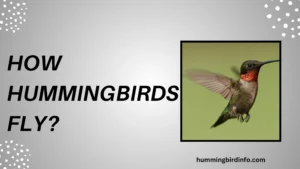Hummingbirds are among the most fascinating creatures in the natural world. Their dazzling feathers, lightning-fast wings, and ability to hover like helicopters make them a true marvel. But one part of their body often gets overlooked — their beaks.
Many people believe a hummingbird’s beak is just a stiff straw for sipping nectar. But the truth is far more interesting. A hummingbird’s beak is not only flexible, but it plays a crucial role in feeding, hunting, and even communication.
So, can hummingbirds open their beaks? Absolutely. And they do it for more than just drinking sweet liquid. In this article, we’ll explore the anatomy, function, and adaptation of their beaks to understand how such a tiny bird manages such big jobs.
Contents
Anatomy of a Hummingbird Beak
A hummingbird’s beak is made of an upper mandible (maxilla) and a lower mandible. These parts are built from bone, covered with a thin layer of keratin, which makes them both lightweight and durable.
Beak shapes vary across species — some are straight, others are curved, and a few are extra long. This variety helps them access different flower types, each suited to their specific feeding habits.
Tiny muscles control the beak’s movement, allowing them to open and close precisely. Though they don’t open wide like songbirds, their fine control is perfect for their size and feeding style.
The beak also works closely with the tongue, which is long and forked at the tip. It slides in and out rapidly, making the beak a kind of guiding tube for nectar collection.
The Mechanics of Opening
Hummingbirds don’t need to open their beaks wide to eat nectar. Instead, they use small openings to allow their tongues to extend deep into flowers or feeders.
They possess a special ability called rhynchokinesis, which means they can slightly bend their upper beak. This flexibility helps them better access nectar and capture tiny insects.
While most feeding uses small openings, they sometimes open their beaks wide when hunting. This is helpful for catching insects mid-air or for cooling themselves down during hot days.
High-speed cameras have shown how fast and controlled these movements are. Researchers use this footage to understand how hummingbirds make such precise beak motions in real time.
Even though their gape is small compared to other birds, their accuracy and timing are unmatched, especially when targeting tiny prey or drinking from narrow flower tubes.
Why Hummingbirds Open Their Beaks
Hummingbirds open their beaks to feed on nectar, sliding their tongue in and out nearly 20 times per second. The tongue works like a tiny pump, drawing liquid through capillary action.
They also need insects for protein, especially during breeding. To catch bugs, they snap their beaks open quickly and trap them mid-flight with amazing precision.
When temperatures rise, hummingbirds open their beaks to release heat. This behavior, similar to panting in dogs, is called evaporative cooling and helps them avoid overheating.
Hummingbirds are also vocal creatures. They chirp, trill, and buzz, all of which require them to open their beaks to produce sound, especially during territorial displays.
During fights or defense, they may open their beaks wide to intimidate rivals. Some even use their beaks as weapons, jabbing at intruders or competitors near feeders.
Beak Adaptation and Evolution
Hummingbirds have evolved alongside flowers in a process called coevolution. As flowers changed shape, hummingbird beaks adapted to match them perfectly for nectar access.
Natural selection shaped their beaks for feeding efficiency, insect catching, and even nest building. Only the most adaptable shapes passed through generations.
Species like the sword-billed hummingbird have beaks longer than their bodies. Others have curved beaks to match spiraled flowers. This variety is a product of diet and environment.
All this change is backed by genetic variation that controls beak size, shape, and growth. Scientists are still discovering how DNA influences these features.
These beak differences allow each hummingbird species to occupy its own ecological niche, reducing competition and helping them thrive across different habitats.
More Than a Straw – The True Power of the Beak
Hummingbird beaks are multi-functional tools, not just straws. They help in feeding, hunting, communication, and even cooling off.
Their beaks are built for precision and speed, letting them drink, hunt, and react faster than most birds their size. Every part of the beak is finely tuned for efficiency.
So, yes — hummingbirds can open their beaks, and they do it often for reasons critical to their survival and success in the wild.
Conclusion
The hummingbird’s beak is a small but mighty structure, far more complex than it appears. With muscles, bones, and flexibility, it allows the bird to do so much more than sip nectar.
They open their beaks to feed, hunt, cool off, and even communicate. This behavior plays a vital role in their everyday survival and interaction with their environment.
Over millions of years, hummingbirds have evolved beaks that are beautifully adapted to the world they live in. So, next time you see a hummingbird, remember — that little beak holds a whole world of power and precision.
FAQs
1. Can hummingbirds open their beaks?
Yes, hummingbirds can open their beaks, although not as wide as other birds. They open them for feeding, hunting, and vocalizing.
2. Do hummingbirds open their beaks when feeding?
Yes, they slightly open their beaks to extend their tongue, which collects nectar from flowers and feeders.
3. Can hummingbirds catch insects?
Absolutely. They use quick snap-and-grab motions to catch small insects and spiders mid-air.
4. Why do hummingbirds open their beaks wide sometimes?
They may open wide to cool off, catch insects, or show aggression during territorial disputes.
5. What is rhynchokinesis in hummingbirds?
It’s a special ability to flex the upper beak, allowing them to feed more effectively on certain flower shapes.
6. Do all hummingbirds have the same type of beak?
No. Beak shapes vary widely across species depending on their diet and the flowers they feed from.








